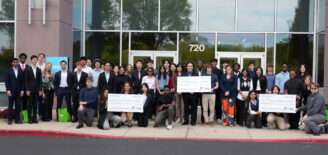How listening and empathy are fueling growth at software startup Authenticx
Sometimes the pent up demand for new tech is so great that it can rocket a market like customer experience management into double-digit compound annual growth. To be exact, customer experience related sales are projected to grow 11.8% over the next five years. But tucked into customer experience management’s impressive growth is a second story with speech analytics. This even newer software category will grow 20.2% during the same time period, bumping speech analytics from $1.5 billion to a $3.8 billion market of its own by 2025.
Pent up demand and robust market growth is one explanation for the early success of Carmel, Ind.-based customer listening software startup Authenticx. Launched in 2019 by Amy Brown—TechPoint’s 2020 Rising Entrepreneur Mira Award winner—Authenticx has nearly tripled its employee count and quadrupled its revenue in 2020.
“Like everyone else, we were holding our breath in March waiting to see if the pandemic would have an impact on our growth or not,” Amy said. “But we were able to close new deals and we had more growth with our existing clients, which helped us meet our revenue goals for the year a little early.”
Since the health and hospital systems vertical market has been all-consumed with the COVID-19 crisis for most of the year, Authenticx shifted its focus to the other two legs of its go-to-market milking stool.
“While they were not unaffected by the pandemic, we have found some really good traction with pharmaceutical companies and healthcare payers like insurance companies,” Amy said. “Because they are less involved in direct patient care, they still have the bandwidth to continue with their digital transformations, including implementing digital solutions like speech analytics or what we call customer listening software.”
That phrase “customer listening” is a second explanation for why Authentix is finding success and growing so fast. It’s also a key to understanding what differentiates the company’s product from its much larger competitors.
Five to ten years ago, measuring the customer experience was thought of as a nice-to-have extra in the business world. Cynics would have called it “cute.” First of all, measuring the customer experience was nearly impossible without a massive budget and the technologies we have today, but the value and ROI of the sum total of a customer’s interactions with a brand is a recently defined specialty itself.
The Affordable Care Act, however, flipped healthcare and many ancillary businesses on their heads when it prioritized outcomes over procedures, and anything that affects 1/6th of the U.S. economy is going to have ripple effects on the rest of it. Suddenly, the patient experience became more important than ever to the bottom line of healthcare providers, which has created a financial advantage for those equipped to listen.
“Nothing replaces listening. And when we say listening, we literally mean listening,” Amy said. “One of the biggest problems with the speech analytics industry today is that it’s pretty standard practice to remove the human elements and present the customer experience as word clouds and data alone. But when you lose the context for that data, the human interactions, it’s no longer actionable.”
For example, standard speech analytics software based on keywords may tell an insurance executive that 20% of her customers are using the word frustrated or frustrated and co-pay card, but she won’t know why customers are frustrated unless she listens to the actual conversations between those customers and customer service agents.
Improving your customer experience rating by half of one percent to a company like UnitedHealth Group—the world’s largest healthcare company by revenue at nearly $250 billion—translates into millions of dollars of added revenue. Of course, dropping by half of a point means losing millions. Funders of healthcare are looking at the clinical outcomes and the experiential outcomes, and that’s a huge reason why the customer experience has more of a direct ROI today than it ever has in the past.
Amy explained one of the things that is fatiguing to leaders out there who have already spent millions of dollars on speech analytics, is that they are not using it to inform their daily business decisions. Everything they need to get actionable information about their customers is already there, they just lack the tools to turn it into a return on their investment.
“The whole premise of how Authenticx uses speech analytics is different,” Amy said. “We use speech analytics to identify content that should be sampled and curated for human beings to actually listen to; we call it a montage. We’re using it to surface insights that actually enhance a human’s understanding of another human, not trying to eliminate the humans from the equation. We make it more accessible and efficient to listen and more content relevant to the things that company leaders are listening for. We use actual customer voices to tell stories that really need to be told within corporate America.”
One client that hired Authenticx just as the pandemic was first surging in March 2020, had an immediate concern about billing and whether or not payment policy changes were necessary as talk of job losses and a potentially serious economic downturn became pervasive. Hearing the actual customer voices triggered empathy among the management team that would be impossible to communicate via word clouds or pie charts alone. Simple and low-cost solutions like a new grace period and payment plans provided a way for the client to side-step a landslide of uncomfortable and negative interactions with customers whose experiences, instead, left them feeling grateful.
“What motivates me every day is not our company size or revenue,” Amy said. “Don’t get me wrong, I’m competitive and I definitely want to see us grow to $100 million in the next few years. But that’s not what motivates me. What motivates me is this idea that Authenticx can transform and disrupt a market that is just not good enough yet. I want us to succeed at helping corporate America regain its sense of humanity by leveraging our technology to listen and to better understand customers.”




